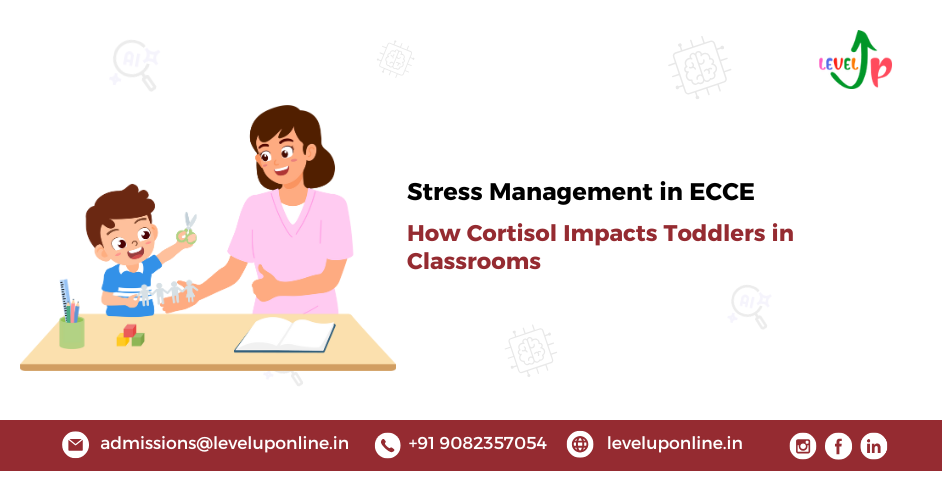Introduction
Tiny backpacks, colorful puzzles, storytime songs—it sounds like a dream. But inside these vibrant ECCE (Early Childhood Care and Education) classrooms, something invisible might be at work: stress. And not the grown-up kind. We’re talking about elevated cortisol levels—the body’s chemical signal that things aren’t okay—even in toddlers.
In this blog, we uncover the less-talked-about link between cortisol, the learning environment, and stress management in ECCE. If you thought stress was a grown-up problem, think again.
What is ECCE and Why It’s a Game-Changer
ECCE is more than pre-school. It’s where foundational brain wiring happens, where toddlers first interact outside their homes, and where lifelong learning habits are formed. But behind the games and rhymes, little brains are absorbing everything—including pressure. That’s why stress management in ECCE is not optional; it’s essential.
The Untold Story: Do Toddlers Really Experience Stress?
Surprisingly, yes—and more than you think. Cortisol, often referred to as the “stress hormone,” is naturally produced by the body. However, toddlers exposed to constant micro-stressors (like loud noises or chaotic routines) can experience chronic cortisol elevation. The result? A brain that’s wired to react, not relax.
What is Cortisol & Why Should Educators Care?
Cortisol is part of our fight-or-flight system, but in toddlers, it works differently. Their neural systems are still maturing, so prolonged cortisol surges can reshape emotional and cognitive development. In ECCE classrooms where stress isn’t noticed, cortisol silently chips away at the child’s ability to focus, learn, and socialize.
How Does Stress Look in a Toddler? Hint: It’s Not Always a Tantrum
One of the biggest misconceptions? Stress in toddlers always looks dramatic. In reality, it’s often subtle:
1. Refusal to make eye contact
2. Sudden withdrawal during group play
3. Digestive issues or disrupted naps
4. Hyperactivity after transitions
Stress management in ECCE begins by recognizing these less obvious signals.
Hidden Triggers of Toddler Stress in ECCE Settings
1. Too Many Choices, Too Soon
While Montessori-inspired freedom has its perks, giving toddlers overwhelming options too early can spark confusion and stress. Structured exploration is the key.
2. Adult Conversations Nearby
Yes, even your whispering matters. Toddlers are sponges. Discussions about evaluations, discipline, or schedules—even in hushed tones—can increase tension.
3. Inconsistent Faces
Frequent changes in caregivers or teachers make toddlers feel insecure. Familiar faces = psychological safety.
The Long-Term Impact of Cortisol on Learning
It’s not just about one rough day. Continuous stress can lead to:
1. Reduced synaptic connections in the prefrontal cortex (affecting memory and attention)
2. Heightened amygdala activity, increasing emotional outbursts
3. Weakened immune response, making toddlers prone to illness
By prioritizing stress management in ECCE, educators help buffer these biological risks.
What Can Educators Do Differently?
✅ Recognize Emotional Red Flags Early
Keep anecdotal records. Patterns of withdrawal, aggressive play, or excessive silence are signs—not just behaviors.
✅ Create ‘Predictable Surprises’
Routine doesn’t have to mean boring. Toddlers love surprises when they feel safe. A surprise puppet story every Wednesday? That’s a routine they can anticipate.
✅ Neutral Tones and Warm Lighting
Cool-toned LED lights and primary-colored chaos can overstimulate. Natural light and earthy tones lower sensory stress.
Creative Classroom Techniques for Stress Management in ECCE
✨ The Five-Minute Reset Ritual
After every group activity, give toddlers 5 minutes of silence or soft sensory play to reset their cortisol levels.
✨ Emotion Stations
Set up a zone with emotion cards, mirrors, and stress balls. Let children label their feelings and choose calming activities.
✨ “Sound Showers”
Use soft ambient noise or nature sounds during transitions. Studies show that nature sounds reduce cortisol within 90 seconds.
The Home-School Equation: Stress is a Shared Responsibility
Parents often mirror stress unknowingly. A rushed goodbye at drop-off or inconsistency in bedtime routines amplifies classroom stress.
Effective stress management in ECCE thrives when:
1. Parents and educators use a shared vocabulary for emotions
2. Children experience similar rules and comfort objects at home and school
3. Daily check-ins happen between both parties
Why Mental Health Training Must Be Part of ECCE
We train ECCE staff to teach numbers, colors, and alphabets—but not always emotional intelligence. That needs to change. Mental health literacy:
1. Helps educators set boundaries
2. Builds resilience in children
3. Reduces teacher burnout
Setting Institutional Standards for Emotional Wellness
Every ECCE center should implement:
1. A well-being framework
2. Regular emotional check-ins
3. A support team including child psychologists or trained counselors
These aren’t luxuries—they’re lifelines.
Conclusion: Cortisol Doesn’t Belong in Childhood
While we can’t protect toddlers from every bump in the road, we can create classrooms where cortisol doesn’t dictate their day. Let’s build ECCE environments that aren’t just colorful and curriculum-focused—but emotionally safe, predictable, and nurturing.
Because the earlier we support their emotional world, the better their real-world journey begins.


